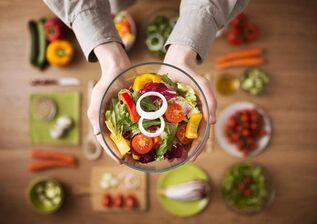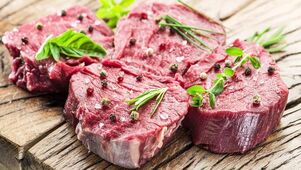Japanese cinema and animation inspire with their authentic atmosphere, fantastic pictures, unbelievable beauty and slimness of Japanese women. The Japanese are considered to be the slimmest people in the world. The secret lies not only in a meager national peculiarity, but also in the moderation of portions and a healthy diet. The name "Japanese Diet" alone is fascinating. What does it take to transform into a fragile geisha? Let's find out!
The reason why the Japanese diet is called is probably not clear, but the results of the approach are impressive - in two weeks you can lose 4-8 kg, depending on your initial weight. According to one source, the approach was developed in one clinic in Tokyo and another - transparency of rules and diets dictates a clear path to achieve this goal. Those who try will be rewarded - reminiscent of the way of a samurai.
The Japanese 14-day diet (original version) is known all over the world. The list of products is affordable and moderate. Japanese nutritionist Naomi Moriyama claims that low-carb foods and moderate servings help maintain youth and longevity.

According to Moriyama's research statistics, the Japanese consume 25% fewer calories than other nations. Fatty foods, fatty foods, and the use of butter on an industrial scale are not popular in the country. Healthy eating and small portions are hallmarks of Japanese culture.
This principle corresponds to the menu of the Japanese diet for 7 days or 2 weeks, despite the differences in ingredients with the diet of the inhabitants of the land of the rising sun.
In this article we analyze:
- principles dictated by the Japanese diet for weight loss;
- the pros and cons of the approach;
- for which Japanese diets for weight loss are not suitable for health reasons;
- basic menu for 7 and 14 days;
- whether you should stay with that.
Samurai Japanese Diet Rules
For the 7, 13, 14 day Japanese diet to be effective, you must adhere to the following rules:
- preparatory preparation - refrain from fast food, fatty products, sweets and salty dishes one week before the start;
- complete elimination of salt, sugar, spices and sauces from food;
- chews food thoroughly to fullness;
- A precompiled menu for the Japanese diet is strictly adhered to during the selected period (7, 13, 14 days).
- It is forbidden to change the order of food days.
- When you wake up, drink a glass of warm water.
- Coffee can be replaced with green tea.
- Compliance with the drinking regime - at least 2 liters of still water. The decay products of animal proteins are excreted and fill the stomach, thereby satisfying hunger.
- The exchange of ingredients or the addition of unauthorized products is prohibited.
- Frequency of using the method - 2-3 times a year. The reason is high levels of stress on the body;
- The exit from the diet should go smoothly so that the lost body fat does not come back.
- The Japanese weight loss diet uses protein foods as the main source. A small amount of carbohydrates in the form of crackers and fiber, and fats from unrefined oils used as dressing for salads, meat, and fish

The strict Japanese diet contains all macronutrients, albeit with one restriction. In this regard, the method can not be called balanced, so the Japanese diet is followed for 7-14 days so as not to harm health.
Even in two weeks, a protein diet can decrease vitality, cause apathy and headaches due to the low amount of carbohydrates in the diet. At the first sign of severe malaise, it is recommended to consume complex carbohydrates or to abandon the diet completely.
Features of the strict Japanese diet for weight loss
The first association with the name "Japanese Diet" - sushi, rice and curry are eaten on the menu every day for breakfast, lunch and dinner for 14 days, but in limited portions. In reality, several features of the approach stand out:
- small portions;
- the amount of caloric intake - 800 kcal;
- Meals are only served three times a day without snacks.
- 14 days - maximum period;
- Salt exclusion.
The essence of dietary nutrition

The basic rule is that the Japanese 13-day diet limits the intake of sugar, salt and carbohydrates. You can lose up to 8 kg of excess weight in 7, 13 or 14 days. Deficiency in macro and micronutrients can lead to serious disruption of body work, so sticking to the approach for longer is extremely undesirable.
There is a 13-day salt-free Japanese diet because oriental people think the number is happy. However, in Europe the number is perceived differently, which is why weight loss takes 7 or 14 days due to suspicion and convenience.
Contraindications
A Japanese diet for one or two weeks is considered rigid and has a number of contraindications:
- with high blood pressure, heart disease, blood vessels;
- diabetes mellitus;
- thyroid disease;
- during pregnancy and breastfeeding;
- gastrointestinal diseases of any complexity, kidney diseases;
- during sports;
- hard physical and mental work.
When it comes to immediately getting rid of the kilograms gained during a festival, it is recommended to bring fasting days ahead - this practice is not harmful to health, it eases digestion and removes the accumulated water during the festivities.
Advantages
The salt-free Japanese diet for 7 and 14 days is currently gaining popularity. What attracts the method:
- the effectiveness of weekly weight loss;
- removal of water from the body;
- Simple nutrition and affordable ingredients.
The first results of the Japanese diet are impressive. At this point, the maximum weight loss occurs due to the release of "ballast" from the water due to the exclusion of salt and the minimal consumption of carbohydrates. In the second week, the weight does not go away as actively because there is no more excess water. Little energy comes from food, so the body is forced to break down its own fats.
However, together with fat, the muscle tissue breaks down. With prolonged care, the quality of the body, in addition to a deterioration in health, leaves much to be desired. It is worth considering whether it is worth it.
Disadvantages

The low-carbohydrate, salt-free Japanese diet does not go away without consequences. Disadvantages of the method:
- excessive calorie deficiency (800 kcal) slows down the metabolism;
- chronic diseases get worse;
- restriction of micro and macro elements disrupts the full function of the body;
- high load on functional systems;
- Coffee instead of breakfast puts a strain on the work of the heart and blood vessels;
- A meager and limited menu creates psychological pressure that is fraught with glitches.
- systematic feeling of hunger that reduces the concentration of attention;
- extreme tiredness, irritability, apathy, decreased performance, dizziness;
- A sharp return to the usual diet will bring back the pounds lost with weight gain.
Recommended and prohibited products
No matter how romantic the name of the weight loss method sounds, there will be no exoticism. The foods that are included in the salt-free Japanese diet are known to Europeans. Ingredients are available and affordable in the supermarket or deli.
Meat and fish dishes with vegetables as a side dish are common. However, excluding salt and spices, bread, cereal, and pasta becomes a psychological test.
List of permitted foods for the menu composition:

- Protein - sea fish, beef, veal, chicken fillet, eggs, low-fat hard cheese;
- drinks - water, natural coffee, green tea, homemade tomato juice without salt, kefir 0, 1-1%;
- croutons with dark bread;
- Dietary fiber (vegetables) - carrots, cabbage, zucchini, eggplant, parsnip root;
- fats - unrefined oils (olives, vegetables);
- fruits - green apples and pears, citrus fruits.
Food ingredients that are not on the list remain prohibited.
Menu for 7 days
In the menu of the Japanese diet for 14 days, a limited food set, a table of specific nutrition helps you to clearly check this.
Days / Meals |
Breakfast |
Lunch |
Dinner |
Monday |
Coffee |
2 eggs, a glass of tomato juice, coleslaw with butter |
200 g sea fish |
Tuesday |
Coffee, dark bread crouton |
200 g fish, coleslaw with butter |
100 g beef, a glass of kefir |
Wednesday |
Coffee |
1 egg, salad made from 3 large boiled carrots with butter |
2 apples |
Thursday |
Coffee |
Zucchini or parsnip root, 1-2 apples |
100 g beef, coleslaw, 2 eggs |
Friday |
1 cooked or raw carrot with lemon juice |
500 g sea fish, a glass of tomato juice |
2 apples |
Saturday |
Coffee |
500 g chicken breast, coleslaw with carrots (or an ingredient) |
2 eggs, buttered carrots |
Sunday |
Coffee |
100 g beef, 2 apples or pears |
Any variation from the previous days, except apples |
Cooking method: steamed, boiled, baked. Roasting is excluded.
Japanese diet for 14 days: the main thing in a nutshell

If the first week was given without disturbances and the state of health allows you to continue, then in the second week the menu of the first seven days is repeated or the menu is made a little more varied.
Menu for 14 days
It is forbidden to rearrange meals or days.
1 day |
Breakfast: Coffee without milk and sugar / cup of green tea Lunch: steamed cabbage with a little olive oil, tomato juice, 2 hard-boiled eggs Dinner: 200 g cooked fish |
Day 2 |
Breakfast: a small piece of rye crouton, coffee or green tea Lunch: 200 g cooked fish, coleslaw with butter Dinner: 100 g boiled beef, 1 glass of kefir 0, 1-1% |
Day 3 |
Breakfast: a small piece of rye crouton, coffee or green tea Lunch: Zucchini or eggplant fried in vegetable oil (unlimited amount) Dinner: 200 g boiled beef, white cabbage with a little oil, 2 boiled eggs |
Day 4 |
Breakfast: grated carrots with lemon juice Lunch: 200 g cooked fish, a glass of tomato juice Dinner: 200 g apples |
Day 5 |
Breakfast: grated carrots with lemon juice Lunch:200 g cooked fish, a glass of tomato juice Dinner:200 g grapefruit |
6 days |
Breakfast:Coffee or green tea Lunch:boiled chicken fillet, cabbage and carrot salad with vegetable oil Dinner:2 hard-boiled eggs, small fresh carrots |
7 days |
Breakfast:Coffee or green tea Lunch:200 g boiled beef Dinner:200 g pears or 200 g boiled fish / b2 boiled eggs with a small fresh carrot / 200 g boiled beef and 1 glass of low-fat kefir |
Day 8 |
Breakfast:Coffee or green tea Lunch:boiled chicken fillet, salad made from fresh cabbage and carrots with vegetable oil Dinner:2 hard-boiled eggs, small carrots |
Day 9 |
Breakfast: grated carrots with lemon juice Lunch: 200 g cooked fish, a glass of tomato juice Dinner:200 g apples |
Day 10 |
Breakfast:Coffee or green tea Lunch:1 hard-boiled egg, 3 small carrots, 50 g cheese Dinner:200 g oranges |
11 days |
Breakfast: a small piece of rye crouton, coffee or green tea Lunch:Zucchini or aubergine fried in vegetable oil Dinner:200 g boiled beef, 2 hard-boiled eggs, fresh coleslaw with vegetable oil |
Day 12 |
Breakfast: a small piece of rye crouton, coffee or green tea Lunch:200 g cooked fish, fresh cabbage salad with oil Dinner: 100 g boiled beef, 1 glass of kefir 0, 1-1% |
Day 13 |
Breakfast:Coffee or green tea Lunch:2 hard-boiled eggs, boiled cabbage with vegetable oil, a glass of tomato juice Dinner:200 g fish cooked or fried in vegetable oil |
Day 14 |
Breakfast:Coffee or green tea Lunch:200 g cooked or fried fish, fresh coleslaw with oil Dinner: 100 g boiled beef, 1 glass of kefir 0, 1-1% |
14-day Japanese diet shopping list
For the sake of simplicity, the following is a list of the shopping basket for a two-week meal:

- Coffee (ground or beans) - 1 pack;
- green tea (without flavors, additives) - 1 pack;
- chicken eggs - 2 dozen;
- sea fish fillet - 2 kg;
- lean beef - 1 kg;
- chicken fillet - 1 kg;
- unrefined vegetable oil - 500 ml;
- white cabbage - 2 forks;
- carrots - 3 kg;
- zucchini, eggplant - 1 kg;
- apples, pears, citrus fruits - 2 kg;
- tomato juice - 1 l;
- kefir 0. 1-1% - 1 l;
- lemons - 2 pcs. ;
- rye bread - 1 loaf (dry in the oven).
Japanese diet for one month
Not practiced for more than 14 days because the diet is monotonous and the calorie content is low. At least if you have a clear mind.
Preparation phase and exit
The preparation phase lasts one week. The use of salt is reduced to a minimum, sweets, flour, cucumbers, preservation, fruits and berries, dairy products are excluded.
The day before the start, a fasting day will be held for a product. This allows the body to adapt to small portions and calories. Warm water helps satisfy hunger pangs, and chewing thoroughly will help you feel full.
If you return to your normal diet abruptly, it will create a stressful state in the body, overload the digestive tract, and bring back the lost weight. Therefore, the exit from the Japanese diet is organized according to the principles of proper nutrition. Display menu:

- Breakfast: liquid oat flakes in water with a spoonful of honey, coffee without sugar;
- Snack: a handful of dried fruits and nuts;
- Lunch: boiled beef with brown rice, fresh vegetables;
- afternoon snack: low-fat cottage cheese with berries;
- Dinner: vegetable salad with sour cream, baked fish.
The menu must be maintained for several days, increasing the serving size daily to the required daily calorie intake.
Why you shouldn't choose a Japanese diet
The Japanese diet does not form a healthy eating habit due to its short duration, which is fraught with disorders. The lack of healthy dietary rules leads to disorders. If you do not adhere to the previous menu to finish the Japanese diet, the pounds you lost will return as the amount increases, time and health will be lost.
The best solution is to choose a technique that will teach you how to eat properly and become a lifestyle. It can be a paleo diet or an elementary appearance of a deficit in daily caloric intake with an increase in the amount of protein food.
The weight loss format is a personal choice for each person. Before doing this, however, it is necessary not only to think about the realism and the attainability of the goals set, to evaluate the possibilities and to weigh all the advantages and disadvantages. Don't forget that health is for life.
Find out more about the Japanese diet
To understand the basic rules of such a diet, you need to understand the Japanese yourself. What do we know about your nation? They are characterized by solidity and a leisurely approach to any company. And food is no exception. The Japanese diet has no clear boundaries. It can take from 13 days to 13 weeks.
Someone might find this diet boring and hungry. In fact, their menu is very satisfactory and varied. As I said, it must be at least 13 days old. And the most important thing, as with any weight loss diet, is a smooth transition from normal to dietary nutrition and vice versa.
The basic principles of the Japanese diet are to speed up and optimize the body's metabolism. All components of the diet are selected very carefully and you should not replace the product with another, even if the replacement seems the same to you. We also do not recommend changing the order of the days.
Eat lightly the evening before your diet. You can eat with chopsticks during your diet. Immerse yourself in the atmosphere of the Far East, and the diet won't be as irritating and boring as the others!
Diet menu
The Japanese diet is based on the intake of protein foods for weight loss and a limited intake of carbohydrates and fats, which are quite strict and severe. The menu includes fish, meat, eggs, juices, vegetables, as well as boiled and mineral water
Like any diet, the Japanese diet has its drawbacks. It is not rich in trace elements and vitamins, it provides for the use of black coffee. If it is contraindicated for you, contact your doctor. Maybe he'll replace it with black or green tea. Do not use salt, sugar, flour, or alcohol.
Conclusions
You have probably noticed that the Japanese are often healthy people known for their longevity. Have you met overweight people in Japan? Rare. In Japan, compared to other parts of the world, it is common to eat low-calorie foods. People in our regions can also try the Japanese diet, which is considered very effective and very popular.
opinions
Opinions about the Japanese diet vary widely. Someone says this is a really working diet with amazing results while others blame it for being too harsh. Negative reviews from doctors are based on the fact that the Japanese diet puts a heavy burden on the kidneys due to the consumption of protein in large quantities.
Anyway, on the way to a perfect body, you should be careful with all popular diets. Before you start losing weight and changing your diet, it is a good idea to consult a specialist, as your main goal is to become the best, not to go to the hospital.





























